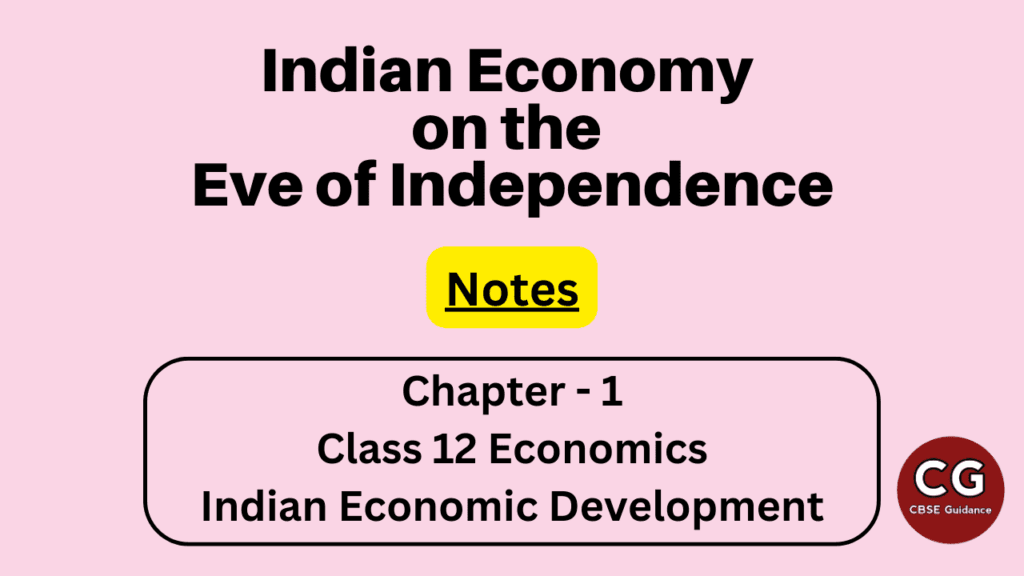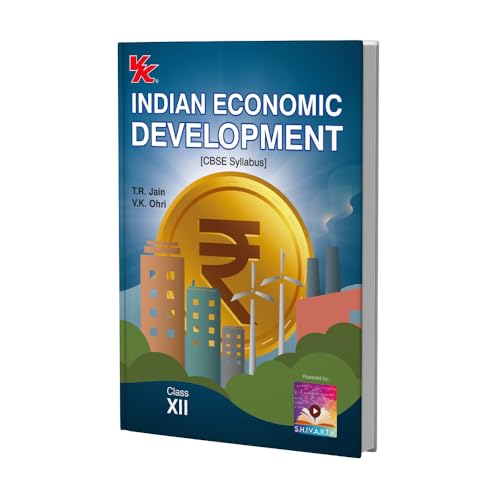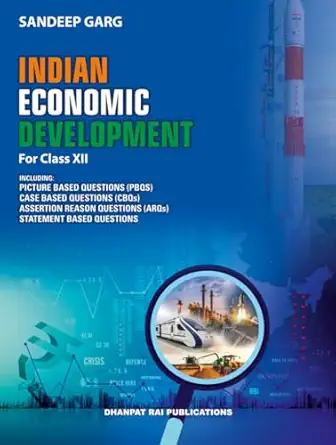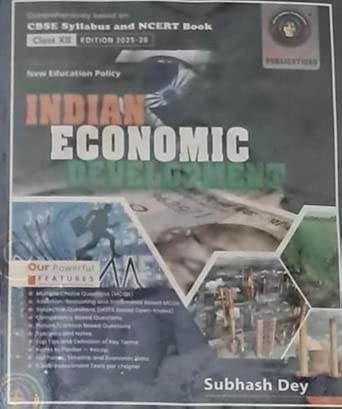If you're a class 12 student studying Indian Economic Development, you may be interested in learning about the Indian economy on the eve of independence. This period marked a significant shift in India's economic landscape, and understanding it can help you better understand the country's current economic situation. Check out these comprehensive notes and study materials to help you ace your exams.

| Board | CBSE and State Boards |
| Class | 12 |
| Subject | Economics |
| Book Name | Indian Economic Development |
| Chapter No. | 1 |
| Chapter Name | Indian Economy on the Eve of Independence |
| Type | Notes |
| Session | 2025-26 |
Many of life's failures are people who did not realize how close they were to success when they gave up.
- Thomas A. Edison
The sole purpose of the British colonial rule in India was to reduce the country to being a raw material supplier for Great Britain’s own rapidly expanding modern industrial base.
Low Level of Economic Development Under the Colonial Rule
- India was particularly well known for its handicraft industries in the fields of cotton and silk textiles, metal and precious stone works, etc.
- The policies of the colonial government that led to a low level of economic development during the pre-independence period were:
- Economic policies of the colonial government aimed at the protection and promotion of colonial economic interests.
- India became a supplier of raw materials to British industries.
- India became a consumer of finished industrial products from Britain.
- The notable estimators of National Income and per capita income were Dadabhai Naoroji, William Digby, Findlay Shirras, V.K.R.V. Rao, and R.C. Desai.
- Most studies found that India’s national income growth in the pre-Independence era was less than 2%, and per capita income growth was half percent.
Agricultural Sector
- 85% of the population depended on agriculture.
- The agricultural sector experienced stagnation and deterioration.
- Reasons:
- Land settlement systems: Under the zamindari system, zamindars only cared about collecting rent, not improving farms.
- Terms of Revenue settlement: Zamindars had to pay fixed revenue on time or lose their land, so they pressured farmers.
- Poor Technology: Farming tools and methods were very basic.
- No Irrigation: Very few proper irrigation facilities were available.
- No Fertilizers: Hardly any use of fertilizers to improve soil.
- No Investment: No spending on terracing, flood control, drainage, or fixing salty (desalinized) soil.
Industrial Sector
- The primary motive of the colonial government behind this policy of systematically deindustrializing India was:
- Making India a raw material supplier for the upcoming modern industries in Britain.
- Making India a sprawling market for the finished products of those industries.
- During the second half of the nineteenth century, modern industry began to flourish slowly.
- Cotton and jute textile mills were set up.
- The cotton textile mills were located in the western parts of the country, namely, Maharashtra and Gujarat.
- The jute textile mills were concentrated in Bengal.
- The Tata Iron and Steel Company (TISCO) was incorporated in 1907.
- A few other industries like cement, paper, sugar, etc. came up later.
- Capital Goods Industry: The capital goods industry means industries that can produce machine tools which are, in turn, used for producing articles for current consumption.
- The growth rate of the new industrial sector was very small.
- The contribution of the industrial sector to GDP was very small.
- The new industrial sector was a very limited area of operation of the public sector.
Foreign Trade
- India became an exporter of primary products such as raw silk, cotton, wool, sugar, indigo, jute, etc., and an importer of finished consumer goods like cotton, silk, and woolen clothes and capital goods like light machinery produced in the factories of Britain.
- The colonial government maintained a monopoly over India’s trade:
- More than half of India’s foreign trade was restricted to Britain while the rest was with China, Ceylon (Sri Lanka), and Persia (Iran).
- The opening of the Suez Canal in 1869 further helped to intensify British control over India’s foreign trade.
- The generation of a large export surplus came at a huge cost to the country’s economy:
- Several essential commodities – food grains, clothes, kerosene, etc. were scarcely available in the domestic market.
- The export surplus did not result in any flow of gold or silver into India.
- The export surplus was used to make payments for the administrative expenses of the British, war expenses, and import of invisible items (leading to the Drain of Indian Wealth).
- The opening of the Suez Canal in 1869-
- reduced the cost of transportation and
- made access to the Indian market easier.
Demographic Condition
- The population of British India was first collected through a census in 1881.
- India entered the second stage of demographic transition after 1921.
- The year 1921 is regarded as the ‘Year of the Great Divide’.
- Some Social Development Indicators:
- The overall literacy level was less than 16%. (Female literacy rate was 7%).
- Public health facilities were either unavailable or inadequate.
- The overall mortality rate was very high.
- Alarming infant mortality rate (218/1000).
- Life expectancy was also very low – 32 years.
Occupational Structure
- Meaning: Distribution of working persons across different industries and sectors.
| Sectors | % of the workforce engaged |
| Agriculture | 70-75 |
| Manufacturing | 10 |
| Services | 15-20 |
- Regional Variation
- In old Madras, Bombay, and Bengal, fewer people worked in farming, and more people started working in manufacturing and services sectors.
- But in states like Orissa, Rajasthan, and Punjab, more people started working in farming during the same time.
Infrastructure
Roads
- The roads that were built primarily served the purpose of
- mobilizing the army within India.
- drawing out raw materials from the countryside to the nearest railway station or the port to send these to far away England or other lucrative foreign destinations.
Railways
The British introduced the railways in India in 1850.
Impacts:
- It enabled people to undertake long-distance travel and thereby break geographical and cultural barriers.
- It fostered the commercialization of Indian agriculture which adversely affected the self-sufficiency of the village economies in India.
- The volume of India’s exports expanded but its benefits did not accrue to the Indian people.
The post and telegraph were developed to serve the objectives of maintaining law and order situation in India.
The positive contributions made by the Britishers in India were:
- Better Transport: Roads and railways built by the British boosted trade and social connections.
- Money System: India moved from barter (goods for goods) to using money for buying and selling.
- Modern Farming: British introduced cash crops like tea, coffee, and cotton, bringing new farming methods.
- Postal and Telegraph Services: Improved communication across India.
- Introduction of Modern Education: Set up schools, colleges, and universities teaching modern subjects like science and English.
Also See:
- Indian Economy on the Eve of Independence MCQ Test
- Indian Economy on the Eve of Independence Class 12 Important Questions and Answers
| Also See: Class 12 Important Questions |
Hope you liked these notes. Please share this with your friends and do comment if you have any doubts/suggestions to share.




Thanks for this notes
Thanks for this notes 😇😇…
Amazing they are….
Sir agar ye notes taiyaar krle or ncert underline wali pdf na padhe to kaam ho jayga?
Ha
Nhi
Yeh jo notes h but lengthy hai short notes ni h kya
This blog post provides a well-structured overview of the Indian economy on the eve of independence. The insights into the agricultural practices and industrial conditions of that era are particularly enlightening. It’s a great resource for understanding the historical context and its implications on modern India. Thanks for compiling such informative notes!
this notes are very helpful thanks for notes
thanks for this notes 🙂🙂